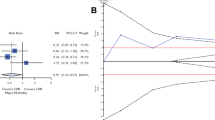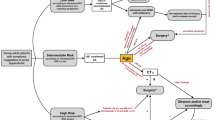Abstract
Background
There are limited data assessing the effectiveness of antibiotics as sole initial therapy in patients with large diverticular abscess. The aim of our study was to compare outcomes of selected patients treated with initial antibiotics alone versus percutaneous drainage.
Methods
All patients with diverticular abscess ≥3 cm in diameter treated in our institution in 1994–2012 with percutaneous drainage or antibiotics alone followed by surgery were identified from an institutional diverticular disease database. Groups were compared based on patient and disease characteristics, treatment failures and postoperative outcomes.
Results
Thirty-two patients were treated with antibiotics alone because of either technically impossible percutaneous drainage (n = 15) or surgeon preference (n = 17) while 114 underwent percutaneous drainage. Failure of initial treatment required urgent surgery in 8 patients with persistent symptoms during treatment with antibiotics alone (25 %) and in 21 patients (18 %) after initial percutaneous drainage (p = 0.21). Reasons for urgent surgery after percutaneous drainage were persistent symptoms (n = 16), technical failure of percutaneous drainage (n = 4) and small bowel injury (n = 1). Patients treated with antibiotics had a significantly smaller abscess diameter (5.9 vs. 7.1 cm, p = 0.001) and shorter interval from initial treatment to sigmoidectomy (mean 50 vs. 80 days, p = 0.02). The Charlson comorbidity index, initial treatment failure rates, postoperative mortality, overall morbidity, length of hospital stay during treatments, and overall and permanent stoma rates were comparable in the two groups. Postoperative complications following antibiotics alone were significantly less severe than after percutaneous drainage based on the Clavien–Dindo classification (p = 0.04).
Conclusions
Selected patients with diverticular abscess can be initially treated with antibiotics without adverse consequences on their outcomes.


Similar content being viewed by others
References
Sandler RS, Everhart JE, Donowitz M et al (2002) The burden of selected digestive diseases in the United States. Gastroenterology 122:1500–1511
Kozak LJ, DeFrances CJ, Hall MJ (2006) National hospital discharge survey: 2004. Vital Health Stat 13:1–209
Beckham H, Whitlow CB (2009) The medical and nonoperative treatment of diverticulitis. Clin Colon Rectal Surg 22:156–160
Place RJ, Simmang CL (2002) Diverticular disease. Best Pract Res Clin Gastroenterol 16:135–148
Daniel F, Scott RS, Sang L et al (2014) Practice parameters for sigmoid diverticulitis. ASCRS. Dis Colon Rectum 57:284–294
Fozard JB, Armitage NC, Schofield JB et al (2011) ACPGBI position statement on elective resection for diverticulitis. Colorectal Dis 13:1–11
The Society for Surgery of the Alimentary Tract. http://www.ssat.com. Patient care guidelines for the surgical treatment of diverticulitis. Accessed March 7, 2013
Kumar RR, Justin TK, Haukoos JS et al (2006) Factors affecting the successful management of intra-abdominal abscesses with antibiotics and the need for percutaneous drainage. Dis Colon Rectum 49:183–189
Labs JD, Sarr MG, Fishman EK, Siegelman SS et al (1988) Complication of acute diverticulitis of the colon improved early diagnosis with computerized tomography. Am J Surg 155:331–336
vanSonnenberg E, Wittich GR, Goodacre BW et al (2001) Percutaneous abscess drainage:up-date. World J Surg 25:362–369
Kaiser AM, Jiang JK, Lake JP et al (2005) The management of complicated diverticulitis and the role of computed tomography. Am J Gastroenterol 100:910–917
Charlson ME, Pompei P, Ales KL et al (1987) Anew method of classifying prognostic comorbidity in longitudinal studies. J Chron Dis 40:373–383
Dindo D, Demartines N, Clavien PA (2004) Classification of surgical complications. A new proposal with evaluation in a cohort of 6,336 patients and results of a survey. Ann Surg 240:205–213
Brandt D, Gervaz P, Durmishi Y et al (2006) Percutaneous CT scan-guided drainage vs antibiotherapy alone for Hinchey II diverticulitis, a case control study. Dis Colon Rectum 49:1533–1538
Tudor RG, Farmakis N, Keighley MR (1994) National audit of complicated diverticular disease: analysis of index cases. Br J Surg 81:730–732
Durmishi Y, Gervaz P, Brandt D et al (2006) Results from percutaneous drainage of Hinchey stage II diverticulitis guided by computed tomography scan. Surg Endosc 20:1129–1133
Siewert B, Kruskal J, Sosna J et al (2006) Impact of CT-guided drainage in the treatment of diverticular abscess: size matters. AJR Am J Roentgenol 186:680–686
Stabile BE, Puccio E, vanSonnenberg E et al (1990) Preoperative drainage of diverticular abscesses. Am J Surg 159:99–104
Swank HA, Mulder IM, Hoofwijk AG et al (2013) Dutch Diverticular Collaborative Study Group. Early experience with laparoscopic lavage for perforated diverticulitis. Br J Surg 100:704–710
White SI, Frenkiel B, Martin PJ (2010) A ten-year audit of perforated sigmoid diverticulitis: highlighting the outcomes of laparoscopic lavage. Dis Colon Rectum 53:1537–1541
Bretagnol F, Pautrat K, Mor C et al (2008) Emergency laparoscopic management of perforatedsigmoid diverticulitis: a promising alternative to more radical procedures. J Am Coll Surg 206:654–657
Elagili F, Stocchi L, Ozuner G, Dietz DW, Kiran RP (2014) Outcomes of percutaneous drainage without surgery for patients with diverticular abscess. Dis Colon Rectum 57:331–336
Ambrosetti P, Chautems R, Soravia C et al (2005) Long-term out-come of mesocolic and pelvic diverticular abscess of the left colon. Dis Colon Rectum 48:787–790
Gaertner W, Willis D, Madoff R et al (2013) Percutaneous drainage of colonic diverticular abscess: Is colon resection necessary? Dis Colon Rectum 56:622–626
Conflict of interest
None.
Author information
Authors and Affiliations
Corresponding author
Additional information
Poster presentation a at the annual meeting of the Society for Surgery of the Alimentary Tract (in conjunction with DDW 2013), Orlando, Florida, May 17–21, 2013.
Rights and permissions
About this article
Cite this article
Elagili, F., Stocchi, L., Ozuner, G. et al. Antibiotics alone instead of percutaneous drainage as initial treatment of large diverticular abscess. Tech Coloproctol 19, 97–103 (2015). https://doi.org/10.1007/s10151-014-1250-9
Received:
Accepted:
Published:
Issue Date:
DOI: https://doi.org/10.1007/s10151-014-1250-9




